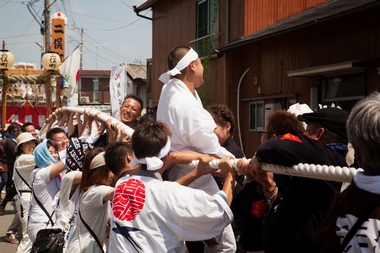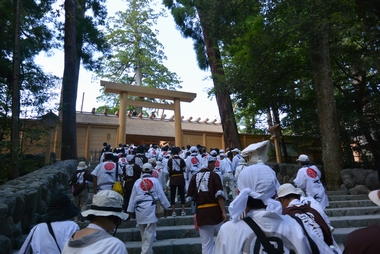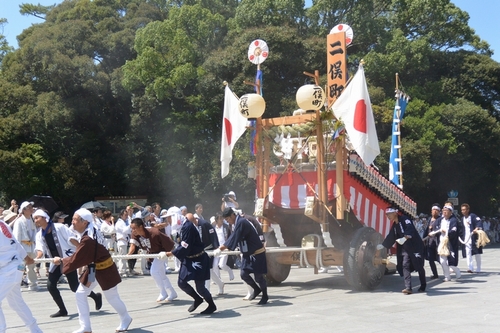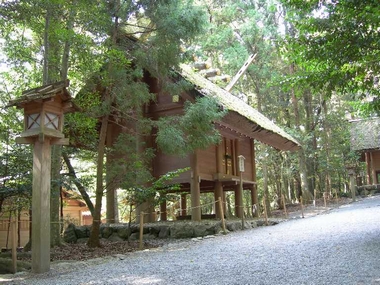September 10, 2013
Rebuilding Every 20 Years Renders Sanctuaries Eternal -- the Sengu Ceremony at Jingu Shrine in Ise
Keywords: Civil Society / Local Issues NGO / Citizen Newsletter Resilience
JFS Newsletter No.132 (August 2013)
Shikinen Sengu ceremony that takes place every 20 years at Jingu Shrine in Ise City, Mie Prefecture will occur this year, 2013. This is an important national event. Its underlying concept -- that repeated rebuilding renders sanctuaries eternal -- is unique in the world. In the occidental way of thinking, creating something durable would normally involve building a structure with robust stones, bricks, and concrete. At this shrine, however, the structures are made exclusively from wood and, by being rebuilt over and over again, can last forever. Also, in the process of rebuilding, the skills of shrine builders and craftsmen in various fields (carpentry, sacred treasures, apparel, etc.) are also passed on from generation to generation.
Local residents participate in two of the ritual events of the the Shikinen Sengu ceremony process -- Okihiki and Oshiraishi-mochi. I was given the valuable opportunity to participate in these events.
This article starts with an introduction of the shrine and the ceremony taken from JFS Newsletter No. 26 (October 2004), which was written based on interviews with shrine personnel.
Japanese people have worshipped at Jingu Shrine, located in Ise City, Mie Prefecture, for two thousand years. Sometimes called "Ise Jingu (Ise Shrine)," it is also simply called "Jingu (the Shrine)," an indication of its pre-eminence. Ise Jingu consists of two parts, Naiku and Geku: Naiku (the Inner Shrine) is dedicated to Amaterasu Omikami, ancestral deity of the Imperial Family, and Geku (the Outer Shrine) is dedicated to the deity of food, clothing, shelter and industry.
The main sanctuary buildings of both Naiku and Geku are built in Japan's oldest architectural style, called "Yuiitsu shinmei-zukuri." Both are constructed using plain Japanese cypress, with a raised floor, a roof thatched with miscanthus grass and "Chigi" (forked finials) at both ends of the roof. The supporting pillars are buried in the ground.
These shrines have been re-constructed at adjacent alternate sites every twenty years without a break for the last 1,300 years; the last time was in 1993. Sacred treasures and apparel belonging to the Shrine are also renewed at this time. This ceremonial system is called the "Shikinen Sengu (or simply "Sengu") and includes various ceremonies related to rebuilding the shrines and transferring the deities from the old to the new buildings. The Sengu system plays an important role in preserving and handing down traditional crafts to the next generation, and conveying the roots of Japanese culture.
This is the only such periodic reconstruction / relocation system in Japan. It is said that the 20-year cycle was determined by Emperor Tenmu (reign 673-686 AD), who established the Sengu ceremony tradition. Thanks to this system, the ancient skills of artisans and carpenters have been passed down to the present.
The main sanctuary buildings follow the style of grain warehouses in the Yayoi Period (about 300 BC to 300 AD), which were used to store seed rice for next year and food in case of famine. Should these stocks run out, it would cause serious disruption, so grain warehouses were vital for protecting the people's lives.
This kind of grain warehouse was normally supported by more than a dozen pillars sunk directly into the ground and had a thatched roof. A great deal of rain usually falls in Japan's early-summer monsoon, and as the thatched roof absorbs rainwater it becomes heavier. The heavy roof presses down on the walls, and this closes gaps between the wall boards, keeping the inside dry. In summer, the roof dries out and becomes lighter, allowing air to pass through the building and this also keeps it dry. Thus, the roof and pillars function together like a living organism to securely protect the seed rice from moisture and pests.
The only way to support a thatched roof designed to increase in weight is to set the pillars directly into the ground. However, with this method, the pillars and the thatched roof eventually start to rot. Thus, the inevitable solution was to reconstruct these warehouses every 20 to 30 years. However, the life-giving seed rice could not be protected if the rebuilding process started only after the old warehouses could no longer be used. Thus, periodic reconstruction of these structures probably became customary, leading eventually to the Sengu ceremonies of Jingu Shrine in Ise, symbolizing buildings that protect life.
Next to each existing sanctuary building at Naiku and Geku there is a vacant alternative site where the next rebuilding takes place. These two sites are used alternately in each Sengu ceremonial cycle. Before the Meiji Period (1868-1912), the old sanctuaries were exposed to the weather and allowed to collapse after the new ones were completed. After the deities were enshrined in the new sanctuaries, the old buildings were left to decay on the adjacent sites.
As many as 10,000 Japanese cypress trees are needed each time the Jingu sanctuaries of Ise are rebuilt. How have people secured so many Japanese cypress trees every 20 years?
The Jingu Shrine itself owns a large parcel of land 5,500 hectares in extent, and over 90 percent of this land is covered in forest. This forest, called the "Misoma-yama," was created as a result of learning from experience in the past. Timber was formerly taken from this forest to use for the Sengu rebuilding ceremony as well as for firewood. In the Edo Period (1603-1867), about 7 to 9 million people - about the same number as in modern times -- came to worship at Jingu Shrine every year. Firewood was needed for these pilgrims, who normally stayed near the site for several days. As a result the local forest was increasingly exploited, and the timber resource became depleted.
During the Edo Period, the central government (the shogunate) designated a forest in the Kiso area owned by the Owari clan in today's Nagano Prefecture to supply timber to Jingu Shrine. However, toward the end of the Edo Period, this forest became Imperial property, and after World War II it was designated a national forest. Jingu Shrine is given priority in purchasing timber for the Sengu ceremony from this forest, but it is not the only buyer of this rather expensive timber.
Thus it became more and more difficult for Jingu Shrine to depend entirely on domestic resources for the Sengu rebuilding ceremony. This possibility was foreseen by shrine staff, who started taking action 90 years ago. Thinking that the shrine should have its own forest to provide timber for reconstruction, the shrine secretariat ("Jingu Shicho," part of the Interior Ministry) formed a forest management plan during the Taisho Period (1912 - 1926), and started planting trees. At the time, the nominal purpose of the project was said to be landscape conservation and enhancement of the water resource recharging function of the Isuzu River, but Japanese cypresses were also planted on southern slopes.
This afforestation plan encompassed a 200-year time-scale, and aimed to start semi-permanently supplying all the timber for the Sengu ceremony from Shrine-owned forest within 200 years. This plan made it possible to obtain one-fourth of the necessary timber for this year's Sengu ceremony from Shrine lands. This proportion will increase every 20 years. Although the remainder must be purchased from other domestic sources, shrine forests are expected to be able to provide all the timber for future reconstruction ceremonies earlier than originally planned.
The Sengu is such a large event that preparations take over eight years, four years alone just to prepare the timber. Logs are soaked in a lumber pond for two years after felling, a method known as "underwater drying," used to leach extraneous oil out of the logs. The logs are then stacked outside for a year to acclimatize them to the severities of the four seasons. It takes another year to saw them into shape, and finally to cover them with Japanese paper to keep them in good condition until the ceremony.
This long curing process strengthens the timber, prevents it from warping or cracking, and prepares it to play its proper part in the ceremony with its central concept of protecting life. The next question is, how are the materials from the old sanctuary utilized after the reconstruction of the new buildings?
The Naiku and Geku sanctuaries each have two large free-standing roof-support pillars. After the Sengu ceremony, these 11-meter tall pillars are used for another 20 years as part of two torii gates that are also reconstructed on Uji Bridge, which guards Jingu Shrine. After this 20-year period, they are again re-used to rebuild other nearby torii gates, at Shichiri-no-Watashi and Seki-no-Oiwake.
All the other parts of the old sanctuaries except these large pillars are distributed to other shrines around the country that need the lumber for their own renovation tasks. In a spirit of husbanding every single piece of wood, this distribution of materials following Sengu ceremonies helps maintain close relationships between Jingu Shrine and other shrines around Japan.
Japan as a nation is said to have been established during the Yayoi Period with the start of rice agriculture. Rice stocks became the people's lifeline and the basis for nation-building, and this spirit survives at Jingu Shrine in Ise. The custom of rebuilding the sanctuaries every 20 years has transmitted reverence for life through the generations, as well as the craftsmanship and skills needed to rebuild the sanctuaries. Ise's Jingu Shrine stands with dignity as the basis of the Japanese spirit, maintaining its close relationships with local people and with shrines across the country, stretching from its two thousand-year history into an infinite future.
Shrine Rebuilding Involves the Entire Region
The Sengu is such a large event that preparations take several years. The logs used for rebuilding that are obtained from local forests are cut in the mountains and floated down the rivers. Timber for Geku is landed from the Miya River, while that for Naiku is landed from the Isuzu River. The timber is transported from the log ponds to the shrine during the Okihiki ceremony, which takes place eight years before the relocation is to be completed. Between May and June of 2006 and 2007, groups formed in more than 80 towns in the Ise area to hold the Okihiki ceremony.
In 2013, the year of the Sengu relocation ceremony, a related ceremony was held in which people pick up, wash and pile up white pebbles from the Miya River to be placed in the grounds of the new sanctuary. This is called the Oshiraishi-mochi ceremony. After a purification ritual, people convey the stones to the sanctuaries in big two-wheeled carts. Tasks are meted out to the various neighborhood associations of the local township, and the participation of many citizens makes it a lively event.
'Play' Leads to 'Resilience'
I was fortunate enough to have had an opportunity to join people from neighborhood associations taking part in the Okihiki and Oshiraishi-mochi ceremonies. In each respective ceremony the timber and the white pebbles are loaded onto beautifully decorated two-wheel carts, to which two long ropes are attached. Hundreds of local participants take hold of these ropes and pull the carts forward. Almost all residents of nearby towns, including children, youths and the elderly, join these holy events.
Between the two ropes of the cart walk youngsters sharply dressed in Happi, the traditional Japanese cotton coat worn at festivals, singing Kiyari-uta, a work song sung during cooperative tasks such as transporting heavy timber or while pebbles, as a way of helping direct the cart-pullers. There are even groups of children serving in this important role. You may think these processions are somber rituals but they are not. They are full of laughter and as inefficient as can be. Actually, the townspeople seem to enjoy the inefficiency itself. The processions are often interrupted and a kind of "play" begins.

Photo by Japan for Sustainability
Whenever a procession stops, the cart-pullers start swinging the ropes up and down. Then, the lines on either side run in toward the middle of the space between the two ropes, and start, not a "tug of war" but a "thrust and push" action pitting one rope against the other. The young navigators between the ropes are squashed as they urge the pullers to do more.
The pullers on one side push their rope toward the other side and the pullers on the other side push back with their own rope. After this back-and-forth action is repeated several times, the cart-pullers are separated, retreat to their respective sides, and again begin to proceed in time with the Kiyari-uta song. But after a few meters, the "thrust and push" game with ropes begins again.
After moving forward a few meters more, now it's time for a break; neighborhood associations along the route to the shrine prepare stopping places to "entertain" cart-pullers. The pullers leisurely enjoy these breaks, chatting over cups of cold tea served free of charge. The result is that it takes several hours to transport the logs or white pebbles to the shrine, even though the distance covered is not so far.
The strongest impression I received while participating in these events was the way this kind of "play," which at first might seem to be a waste of time, helps bring together the people gathered from here and there for these events, and plays a role in creating regional bonds and resilience.

Photo by Japan for Sustainability
These events in which the whole town participates must create in residents a sense of belonging, solidarity and pride in their town. The people are having fun and laughing while tugging and pushing the ropes. The "entertainment" provided by each neighborhood association on the way to the Shrine also seems to provide a venue where young people from different areas can meet each other. Here and there I saw young people enjoy talking while sitting in a circle.
Since these events are held only every 20 years, it is important to foster participants who will play a main role 20 years later and pass down these duties to future generations. I saw one elderly person who probably has experienced these events three or four times saying to young people who perhaps participated in the event as children last time, "I will leave these duties to you next time." I believe that this is how traditions, culture and skills are preserved over time.
More delightfully, members of the Futamata-cho Hoken-dan association, which I was allowed to join with by special dispensation, rejoiced on the day of the Oshiraishi-mochi ceremony because the song sung by the cart-pullers during the procession was one that had been revived after a hiatus of 60 years. This song had not been sung during that time because nobody remembered how sing the song after the 59th Shikinen Sengu. Fortunately, however, Yoshisuke Ohkawa, the head of the Futamata-cho Hoken-dan, managed to remember the tune of the song that he sang at the 59th Sengu when he was eight years old and was able to put together a music score together with his wife. From this episode, I realized that the Sengu ceremony also plays a role as a "device" to preserve the foundations of traditions that contribute to happiness in people's lives.

Photo by Japan for Sustainability
Written by Junko Edahiro
Related
"JFS Newsletter"
- 'Good Companies in Japan' (Article No.4): 'Eightfold Satisfaction' Management for Everyone's Happiness
- "Nai-Mono-Wa-Nai": Ama Town's Concept of Sufficiency and Message to the World
- 'Yumekaze' Wind Turbine Project Connects Metro Consumers and Regional Producers: Seikatsu Club Consumers' Co-operative
- Shaping Japan's Energy toward 2050 Participating in the Round Table for Studying Energy Situations
- 'Good Companies in Japan' (Article No.3): Seeking Ways to Develop Societal Contribution along with Core Businesses




